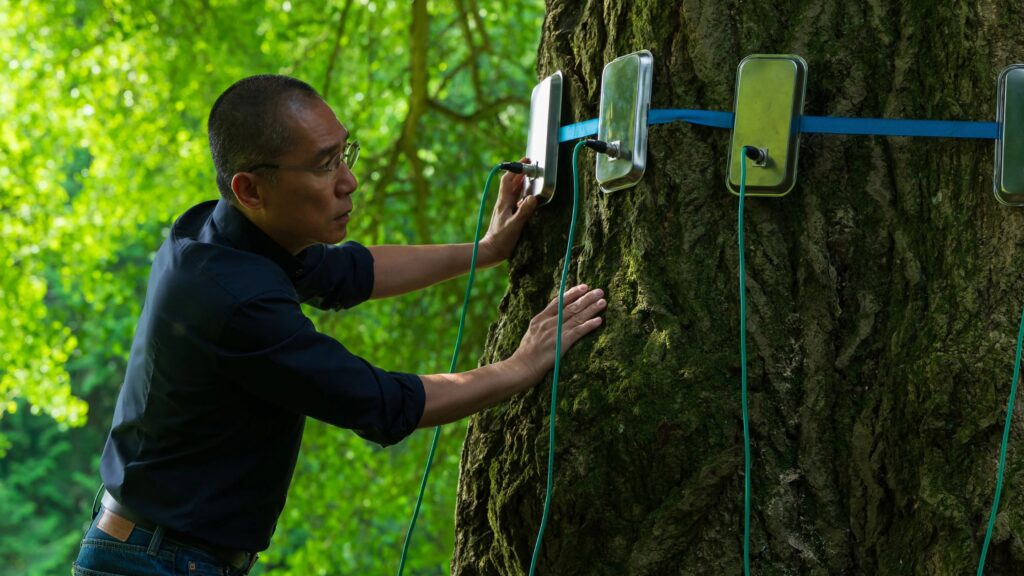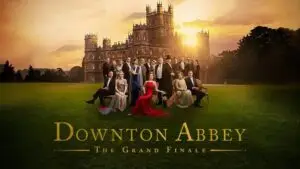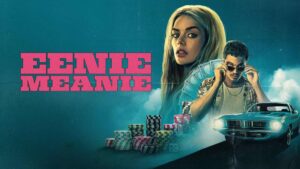Movie blog — Silent Friend (2025): a ginkgo, three lives, and the eloquence of not speaking.
There are movies that tell you a story and movies that teach you how to listen. Silent Friend, the new film from Hungarian auteur Ildikó Enyedi, is emphatically the latter. It’s less a conventional narrative than a patient, sculpted listening exercise: three loosely connected human episodes (1908, 1972, 2020) observed from the vantage of a single, centuries-old ginkgo tree in an old university botanical garden. The tree is the film’s moral and formal axis — a silent witness that gathers human noise and, in Enyedi’s hands, becomes the most eloquent “character” on the screen.
The nuts & bolts (so you know what we’re talking about).
- Title / Director / Writer: Silent Friend, written and directed by Ildikó Enyedi.
- Runtime / Countries / Languages: ~145 minutes; Germany / France / Hungary co-production; German and English among the languages.
- Principal cast: Tony Leung Chiu-wai, Léa Seydoux, Luna Wedler, Enzo Brumm, Sylvester Groth, Martin Wuttke, Yun Huang, Johannes Hegemann, Rainer Bock and others. (If you count the actors who carry substantial screen time across the three episodes, there are roughly 10–14 principal credited performers.).
- Festival debut & awards: World premiere in Venice’s main competition (5 September 2025). The film won the FIPRESCI Prize and Luna Wedler received the Marcello Mastroianni Award for breakthrough performance. It’s since played TIFF and BFI London.
Those basics tell you it’s a film aimed at the festival circuit and arthouse audiences — not a popcorn tentpole — and that it’s being taken seriously on that circuit. The reception at Venice was notably warm: a reportedly long ovation and several critics praising Enyedi’s return to a poetic, elliptical mode.
How many cast — and who carries the picture?
Counting the credited principals who drive the three interleaved stories, Silent Friend uses a compact, international ensemble — roughly a dozen actors with substantial roles (see cast list above). But the film’s dramatic economy is deceptive: each face gets time, space and a private music. Tony Leung is the most prominent international name; he plays Dr. Tony Wong, a Hong Kong neuroscientist who arrives in the pandemic year and becomes the film’s intellectual anchor. Léa Seydoux turns up as a botanist in the same 2020 strand; Luna Wedler plays Grete in the 1972 segment and won Venice’s Mastroianni Award for the role.
If you want a single person to point to as the film’s “lead,” Leung’s character functions as the clearest human viewpoint in the contemporary section. But the true “means character” — the entity through which the film measures time, memory and connection — is the ginkgo tree itself. Enyedi stages the tree as a steady presence, an immovable consciousness that outlives the humans who orbit it. Every human scene is a leaf or a ring around the trunk; the tree is what unites the disparate decades and makes the film feel like one slowly turned portrait. That choice is both audacious and quietly moving.
Box collection / commercial picture.
This is a festival-first art film rather than a mass-market release, so traditional “box-office” metrics are not the most revealing way to measure its impact. Industry listings (Box Office Mojo / festival pages) show the title and credits, but not blockbuster grosses — the film’s life is being built on festivals, critical buzz and selective territory releases rather than wide theatrical play. In short: do not expect blockbuster numbers; expect modest theatrical runs and an emphasis on critical recognition, awards and later platform/TV bookings.
That said, festival prizes (FIPRESCI, Mastroianni) and the Venice premiere matter commercially in the indie sphere: they help European distributors, art-house cinemas and streaming platforms decide to pick it up. For a film like Silent Friend, the “box collection” metric will likely be supplemented by licensing deals (EU broadcasters, arthouse streaming) and the prestige elevator that festivals provide.
The niche — where this film lives and why it’s useful.
Silent Friend sits at the intersection of poetic arthouse, speculative natural history, and quiet humanism. If you like films that privilege mood, metaphor and formal daring over plot mechanics — think Joanna Hogg, Apichatpong Weerasethakul or even some of Terrence Malick’s more meditative work — this film will feel like home. Enyedi’s particular voice is a marriage of visual lyricism and deadpan human observation; she’s interested in the baffling, tender ways humans try to speak to the nonhuman world.
Thematically, the film plays in a few related fields:
- Plant subjectivity / nonhuman listening. The Silent Friend film stages a quasi-scientific imagination (a neuroscientist trying to “listen” to the ginkgo) alongside folk forms of attention. It asks: what if we treated a tree as witness rather than backdrop?
- Time, memory and continuity. Each era offers a different human trouble — the private life of a student in 1972, an intimate family or worker story in 1908, and the pandemic-era scientist probing the tree’s “mind” in 2020 — and the ginkgo organizes them into a single poetic meditation.
- Science vs wonder. The film delights in putting empirical curiosity next to undecidable feeling: the lab equipment, the botanist’s protocols, the student’s small devotional gestures — Enyedi stages the friction and the tenderness.

A deeper look at the structure and the three lives.
The Silent Friend film is formally generous: Enyedi divides her attention across three loosely knotted stories that accumulate meaning by echo rather than linear causality. The ginkgo is the constant; the lives are the variations.
1908 (or the early 20th-century strand). We meet the earliest human interlocutors of the tree: quiet townsfolk, early walking scholars, and the small domestic dramas of a university garden in a pre-war Europe. The film lingers on rituals — pruning, marking, the stories older people tell children — and suggests that the social life of a tree is also a civic memory. (Enyedi’s production design here is tactile and lush.).
1972 (the mid-century strand). This is the segment that won Luna Wedler the Marcello Mastroianni Award. Her Grete is a student whose intimate encounter with the small plants around the ginkgo changes her. Critics flagged this as the film’s emotional heart: a working-class or student perspective that makes ecological attention concrete; a moment when a small human gesture seems to reorient a life. Enyedi uses 1970s textures (Super-8-ish light, period music) to create an immediate world that still converses with the tree’s slow time.
2020 (the present / pandemic strand). The most widely reviewed section: Dr. Tony Wong (Tony Leung) arrives as a neuroscientist intent on surprising experiments — a scientist of minds who dares to ask if plants might communicate. Léa Seydoux’s botanist collaborates. The pandemic backdrop (isolation, lab protocols, the smell of disinfection) gives the scenes sharp contemporary urgency: humans are starved for company, and the tree becomes a site for thinking about what counts as mind, friend, listener. Tony Leung’s humane restraint gives this section a meditative weight; reviewers praised his calm magnetism and Enyedi’s ability to make lab scenes feel like sacred listening.
Across all three vignettes, Enyedi’s camera treats the ginkgo as if it were both narrator and archive: we watch seasons pass in closeups on bark, roots and leaves, and the film composes a slow archaeology of human need. It’s formal filmmaking that trusts the audience’s patience.
What works (and why many critics loved it).
Form & patience. Enyedi’s willingness to linger — on a rusted bench, a scientist’s breath, a tree’s seed — is the film’s primary virtue. Critics called it “hypnotic,” “transfixing” and “beautiful” in early reviews. The film’s textures reward repeated attention.
Tony Leung & ensemble subtlety. Leung’s low-voltage presence anchors the contemporary section, while Wedler’s performance was singled out as revelatory. The supporting ensemble gives the epochs a human center without melodrama.
A new kind of humanism. Rather than sentimentalizing nature, Enyedi stages a rigorous curiosity: science and reverence coexist uneasily and sometimes beautifully. Critics noted the film’s thoughtful attempt to reconfigure how we think about agency and listening.
What doesn’t land for everyone.
No formal experiment is without friction. Several reviewers noted that the film’s ambition produces moments of dissonance:
- Dramatic unevenness. Some critics felt the three episodes are of unequal dramatic weight; the 1972 segment arguably carries the strongest human payoff, while the 1908 material can feel elliptical. That’s intentional but can frustrate viewers expecting a single protagonist arc.
- Science as metaphor. The neuroscientific conceit (listening to plant signals) invites both wonder and skepticism; some viewers may find the scientific scaffolding under-explored or too poetic to satisfy literalists.
- Pacing & patience. If you need plot propulsion, this film’s contemplative tempo will test you. That’s a feature for fans of meditative cinema and a bug for those seeking genre momentum.
Final verdict — who will love it, and why it matters.
Silent Friend is one of those rare festival films that feels like a deliberate offering rather than a utility piece. If you love cinema that asks you to slow down, to honor the nonhuman, and to listen for what cannot be translated into lines of dialogue, this film is a small miracle: formally bold, emotionally patient and conceptually generous. If you prefer more plot or a single, dominant human hero, be prepared to meet the film on its own terms — as a conversation starter rather than an answer machine.
Beyond its pleasures, the Silent Friend film matters because it invites a rethinking of witnessing: in a brittle world, what does attentiveness look like? Enyedi answers — roughly — by asking us to stand still beside a tree for a long time and notice what moves. It’s an oddly radical political gesture: to slow down and to listen is to resist an era of constant interruption. Silent Friend doesn’t preach; it models a practice. And in that modeling, it quietly changes how we might live among the living things that outlast us.





